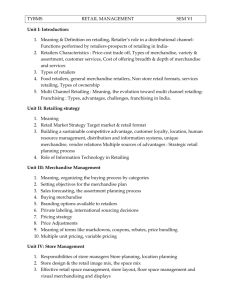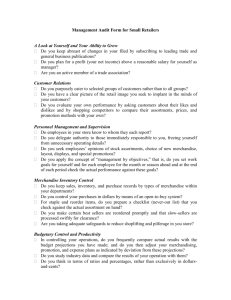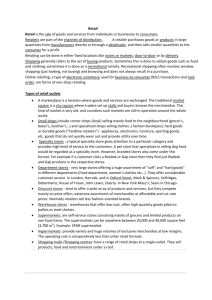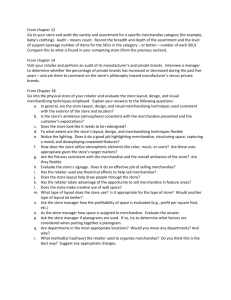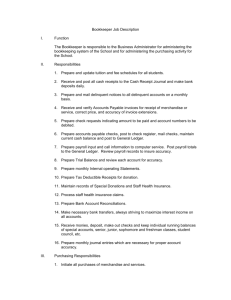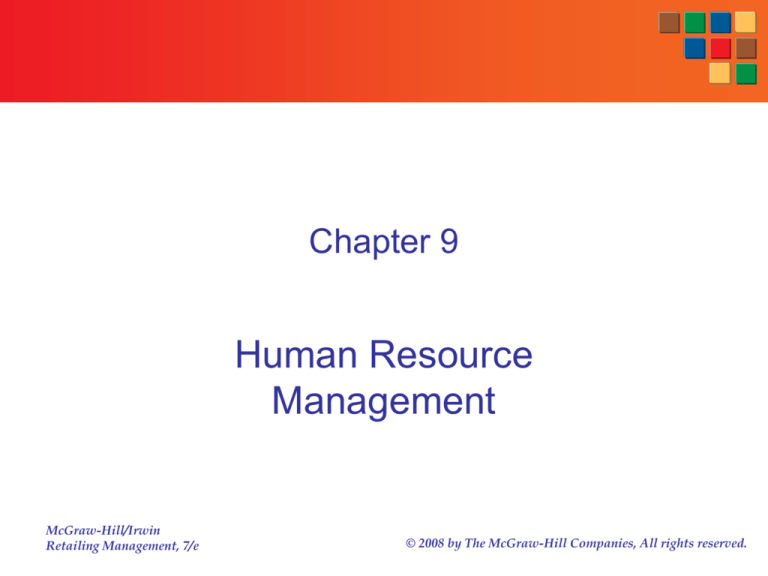
Chapter 9
Human Resource
Management
McGraw-Hill/Irwin
Retailing Management, 7/e
© 2008 by The McGraw-Hill Companies, All rights reserved.
Retailing Strategy
Retail and
Site Locations
Chapter 7,8
Retail Market &
Financial Strategy
Chapter 5, 6
Organizational
Structure &
Human Resource
Management
Chapter 9
Information and
Distribution
Systems
Chapter 10
Customer
Relationship
Management
Chapter 11
09-2
Questions
■ In what way does the management of human resources
play a vital role in a retailer’s performance?
■ How do retailers build a sustainable competitive
advantage by developing and managing their human
resources?
■ What activities do retail employees undertake, and how
are they typically organized?
■ How does a retailer coordinate employees’ activities, and
motivate them to work toward the retailer’s goals?
■ What are the human resource management programs
for building a committed workforce?
■ How do retailers manage diversity among their
employees?
09-3
A study of Sears’ employees found a 5%
increase in employee satisfaction resulted
in a 1.3% increase in customer
satisfaction. This led to a 0.5% growth in
sales.
09-4
Gaining Competitive Advantage through
Human Resource Management
Why does human resource management give a
sustainable competitive advantage?
■ Labor costs account for a significant percentage
of a retailer’s total expenses
■ The customer experiences are determined by
the activities of employees (selecting
merchandise, providing information and
assistance, etc.)
■ These potential advantages are difficult for
competitors to duplicate
09-5
Objectives of
Human Resource Management
■ Short Term
Increasing Employee Productivity
Productivity = Sales/ Number of Employees
■ Long-Term
Employee attitude customer satisfaction and loyalty
long-term performance
Increasing Employee Satisfaction Reducing Turnover
Employee turnover
= # of employees leaving their job during the year
# of positions
09-6
Human Resource Management
Challenges in Retailing
Work Environment
■ Open Long Hours
■ Peak Sales Periods
■ Emphasis on Cost
Control
Employees
■ Unskilled
■ Part-Time
■ Diverse Backgrounds
High Turnover
09-7
Downward Performance Spiral
09-8
Human Resource Triad
09-9
Special HR Considerations Facing
Retailers
■
■
■
■
Need for Part-Time Employees
Demand on Expense Control
Changing Employee Demographics
International HR Issues
09-10
Increasing Workforce Diversity
■ Workforce employing more
minorities, handicapped
people, and the elderly
■ Older workers are more reliable
than younger workers
■ Cost effective as training and
recruitment costs are low
Royalty-Free/CORBIS
09-11
Strategic Issues
Facing Retail HR Professionals
■ The design of the organization structure for
assigning responsibility, and authority for tasks
to people and business units
■ The approaches utilized coordinate the activities
of the firm’s department and employees, while
motivating employees to work toward achieving
company goals
■ The programs used to build employee
commitment, and retain valuable human
resources
09-12
Designing the Organizational Structure
Organizational structure
Identifies the activities to be performed by
specific employees, and determines the lines of
authority and responsibility in the firm
09-13
Tasks Performed in a Retail Firm
09-14
Strategic Management Tasks
Performed in a Retail Firm
■
■
■
■
■
Develop a retail strategy
Identify the target market
Determine the retail format
Design organizational structure
Select locations
09-15
Merchandise Management Tasks
Performed in a Retail Firm
■ Buy merchandise
Locate vendors
Evaluate vendors
Negotiate with vendors
Place orders
■ Control merchandise inventory
Develop merchandise
Budget plans
Allocate merchandise to stores
Review open-to-buy and stock
position
■ Price merchandise
Set initial prices
Adjust prices
09-16
Store Management Tasks
Performed in a Retail Firm
■
■
■
■
■
■
■
■
■
■
■
Recruit, hire, and train store personnel
Plan work schedules
Evaluate performance of store personnel
Maintain store facilities
Locate and display merchandise
Sell merchandise to customers
Repair and alter merchandise
Provide services
Handle customer complaints
Take physical inventory
Prevent inventory shrinkage
09-17
Administrative Management Tasks
Performed in a Retail Firm
■ Promote the firm, its merchandise
and its services
■ Manage human resources
■ Distribute merchandise
■ Establish financial control
09-18
Assignment of Responsibility for Tasks
■
■
■
■
Strategic – Top Management, Board of Directors
Merchandise Management – Merchandise Division
Store Management – Stores Division
Administrative – Corporate Specialists
09-19
Organization of a Small Retailer
09-20
Organization of Macy’s Florida
09-21
Merchandise Division Organization:
Macy’s Florida
09-22
What does a Buyer do?
A buyer is responsible for:
■
■
■
■
■
■
procuring merchandise
setting prices and markdowns
managing inventories
building and maintaining relationships
attending trade and fashion shows
negotiating with vendors on price,
quantities, assortments, delivery dates
and payment terms
■ specifying private label merchandise
© Digital Vision
09-23
What does a category manager do?
■ A category manager
Is responsible for a set of products that are viewed as
substitutes by customers (Ex: all pastas – fresh,
frozen, packed, or canned)
Is evaluated on the profitability of category
Is motivated to eliminate “me to” products and keep
essential niche products
Is used primarily by supermarkets, big box retailers
09-24
Allocator vs. Planner
Allocator – responsible for allocating the merchandise
and tailoring the assortments in several categories for
specific stores in a geographic area.
Planner – responsible for the financial planning and
analysis of the merchandise category. They develop
the budget plan and monitor performance
09-25
Stores Division:
Organization of Macy’s Florida Store
09-26
Corporate Organization of Macy’s Inc.
09-27
Activities Performed at the Macy’s Inc.
Corporate Office
■ Support services and counsel to operating divisions
■ Conceptualizing, designing, sourcing, and marketing
private label and exclusive merchandise sold at Macy’s
and at Bloomingdale’s
■ Overall strategy, product development, merchandising
and marketing of home-related merchandise
■ Logistics, distribution, and operations functions
■ Services all proprietary and VISA credit card accounts
■ Performance of most other non-store services for
customers and employees
■ Development of distinctive sales promotions
■ Provision of an integrated electronic commerce, and
data warehouse systems
09-28
Retail Organization Design Issues
■ The degree to which decision making is
centralized or decentralized
■ The approaches used to coordinate
merchandise and store management
09-29
Centralization vs. Decentralization
Advantages of Centralization
Disadvantages of Centralization
■ Reduce costs (overhead
falls with fewer
managers)
■ Coordinated buying
achieve lower prices from
suppliers
■ Opportunity to have the
best people make
decisions for the entire
corporation
■ Increases efficiency
■ It is difficult for a retailer to
adapt to local market
conditions
■ It may have problems
responding to local
competition and labor
markets
■ Personnel policies make it
hard for local managers to
pay competitive wages
09-30
Methods for Coordinating
Buying and Store Management
Royalty-Free/CORBIS
■ Improving buyer’s appreciation for store environment
■ Buyers making store visits
■ Assigning employees to coordinating roles
09-31
Winning the Talent War
■ Retailers are engaged in a “war” with their
competitors for talent – for effective employees
and managers – who can effectively deal with
the incased complexities of retail jobs (the use of
new technologies, increased profit & loss
responsibilities, increased global competition, a
diverse workforce).
■ Develop programs to attract, develop, motivate,
and keep talent
09-32
Attracting Talent – Employment Marketing
Employment marketing (branding)
Marketing programs that
attract “best and brightest”
potential employees
Starbucks – “Love What You Do”
Southwest – “Free to Actually
Enjoy What You Are Doing”
09-33
Attracting Talent – Employment Marketing
JCPenney
To build its employment brand, JCPenney uses the
tagline “A Perfect Fit” on all correspondence and
advertising directed toward potential employees
09-34
Developing Talent –
Selection and Training
■ Selective Hiring:
Recruit “the right people”
Simply seeking the best and the brightest may not
always be the most effective approach
■ Training:
Increasing investments in management training
programs and developing leaders
Increasing attention to college graduates - Generation Y
09-35
Motivating Talent – Aligning Goals
■ Policies and Supervision
Indicate what employees should do
Behavior Enforced by Managers
■ Incentives
Commission, Bonus, Stock Options
■ Organization Culture
The set of values, traditions, and customs of a
firm that guides employee behavior
Behavior enforced by social pressure
09-36
Use of Incentives
Advantages
■ Aligns Employee and
Company Goals
■ Strong Motivating Force
Disadvantages
■ Employees Only Focus
on Sales
■ Less Commitment to
Retailer
09-37
Developing and Maintaining a Culture
■ Stories
Nordstrom – Hero Service Stores
Ritz-Carlton – “wow story” reading
Whole Foods – working in teams and
using its employees in the hiring
process
Wal-Mart – Saturday Morning Meeting
■ Symbols
■ CEO Leadership
09-38
Keeping Talent –
Building Employee Commitment
■ Empowering Employees
Empowerment is the process of managers sharing power
and decision-making authority with employees
• Gives employees confidence
• Provides greater opportunity to provide service to
customers
• Employees are more committed to firm’s success
■ Creating Partnering Relationships with Employees
Reducing Status Differences
Promotion From Within
Balancing Careers and Families
• Flextime, job sharing
09-39
Issues in Retail Human Resource Management
■ Managing Diversity
Diversity Training
Support Groups and Mentoring
Career Development and Promotions
■ Growth in Legal Restrictions on HR
Practices
Equal employment opportunity
Compensation
Labor relations
Employee safety and health
Sexual harassment
Employee privacy
■ Use of Technology to Increase
Employee Productivity
Keith Brofsky/Getty Images
09-40



